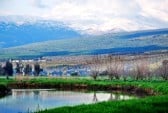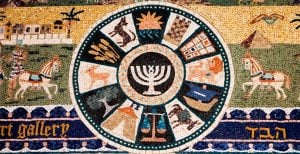Even though Israel is one of the smallest countries in the world, it is one of the most naturally diverse, home to natural landscapes that are usually separated by thousands of miles in other countries. From the snowy mountains of the north to the amazing coral reefs of the Red Sea in the south, while in between are expansive desert areas, sandy beaches, green forests and fertile plains. Interspersed throughout all of them are many important historical and archeology sites. This diversity is represented by about 300 nature reserves and national parks. Here is a look at 10 of the best:
City of David (Jerusalem Walls) National Park
 About 3,00 years ago, King David conquered what is today the city of Jerusalem, making it the capital and spiritual center of the Israelite empire. Today the “City of David” is a fascinating archeological park that tells the history of Jerusalem in Biblical times, including its wars, its prophets and kings, as well as the life of its citizens.
About 3,00 years ago, King David conquered what is today the city of Jerusalem, making it the capital and spiritual center of the Israelite empire. Today the “City of David” is a fascinating archeological park that tells the history of Jerusalem in Biblical times, including its wars, its prophets and kings, as well as the life of its citizens.
The Banias Nature Reserve
The Banias is a beautiful nature reserve in the upper Golan Heights between the Hula Valley and Mount Hermon. On display is a wide variety of natural and historical beauty, from the ruins of ancient cities to cascading waterfalls, including the Banias Waterfall, the biggest waterfall in Israel. At the other end is the Banias spring which leads into the Hermon River. A fan favorite for those visiting the Golan.
Ein Gedi National Park
 Located near the Dead Sea in the Negev Desert, Ein Gedi National Park is an oasis of springs and waterfalls, with a variety of rare plants and animals that appear along the desert mountain terrain.
Located near the Dead Sea in the Negev Desert, Ein Gedi National Park is an oasis of springs and waterfalls, with a variety of rare plants and animals that appear along the desert mountain terrain.
Masada National Park
One of the most iconic places to visit in Israel, Masada is a natural fortress high up in the Judean Desert overlooking the Dead Sea. It is a remnant of the ancient kingdom of Israel and the tragic last stand of Jewish rebels against the Roman army in 73 A.D. It was built as a palace complex by Herod the Great, King of Judaea, (37 – 4 B.C.). The camps, fortifications and attack ramp that encircle Masada are the most complete Roman siege works surviving to this day.
Hula Nature Reserve National Park
 Hula Nature Reserve was the first nature reserve in Israel, and today is home to thousands of aquatic birds, along with many species of rare plants and fish. The Hula Nature Reserve serves as a central station for over 200 species migrating birds between Africa and Europe. Wooden bridges are built above the lake to observe all of the teeming wildlife.
Hula Nature Reserve was the first nature reserve in Israel, and today is home to thousands of aquatic birds, along with many species of rare plants and fish. The Hula Nature Reserve serves as a central station for over 200 species migrating birds between Africa and Europe. Wooden bridges are built above the lake to observe all of the teeming wildlife.
Mount Carmel National Park
The Mount Carmel National Park is a compilation of lush green nature reserves,with a variety of plants and wildlife, along with wonderful panoramas and ancient archaeological sites.
Gamla Nature Reserve
 The Gamla Nature Reserve in the central Golan Heights combines breathtaking panoramic landscapes with a powerful archeological experience. Known as the “Masada of the North,” Gamla was the site of a hard fought and desperate defense against the Romans during the Jewish Revolt in AD 66, and the story of this battle is preserved in these silent remains.
The Gamla Nature Reserve in the central Golan Heights combines breathtaking panoramic landscapes with a powerful archeological experience. Known as the “Masada of the North,” Gamla was the site of a hard fought and desperate defense against the Romans during the Jewish Revolt in AD 66, and the story of this battle is preserved in these silent remains.
Beit Shean National Park
Beit She’an National Park is one of the largest and most impressive archaeological sites in the world. Excavations include an ancient theater that is still in use today, the largest public bath house ever excavated in Israel, the ruins of an ancient temple, a large Roman-era public building in the center of the city and many other ancient sites.
Gan HaShlosha National Park
Gan HaShlosha is a national park near the Sea of Galilee with palm trees, bright blue waters and naturally warm springs where visitors are able to swim all year round. Gan HaShlosha was named as one of the 20 most beautiful parks in the world by TIME Magazine.
Timna National Park
 The geological wonderland of Timna Park is one of the biggest attractions in southern Israel. Timna Park covers about 15,000 acres of Israel’s Negev Desert, a spectacular collection of rock formations and canyons. Millions of years of erosion have sculpted shapes of amazing beauty, such as the red-hued Solomon’s Pillars and Mount Timna, the world’s first ever copper mine.
The geological wonderland of Timna Park is one of the biggest attractions in southern Israel. Timna Park covers about 15,000 acres of Israel’s Negev Desert, a spectacular collection of rock formations and canyons. Millions of years of erosion have sculpted shapes of amazing beauty, such as the red-hued Solomon’s Pillars and Mount Timna, the world’s first ever copper mine.







